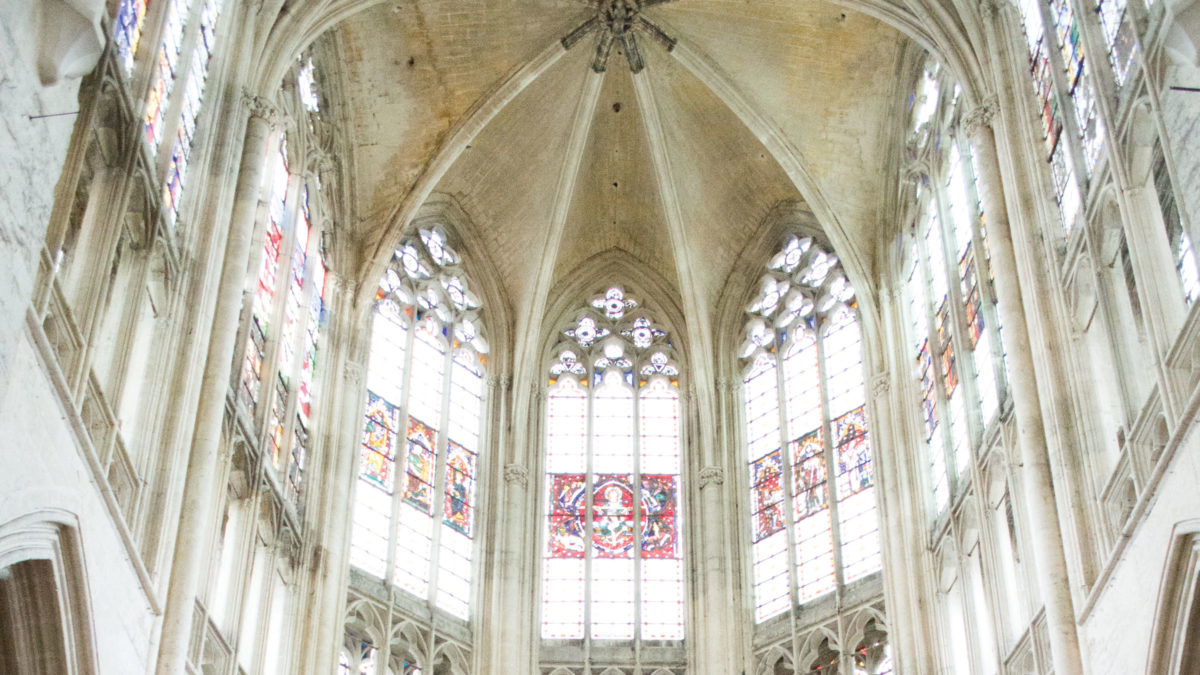A Gothic Church, a Holy Tear
Anne Heath, Ph.d. | Howard R. and Margaret E. Sluyter Associate Professor of Art History
Jesus wept. And for seven centuries, a Benedictine abbey church in France claimed to have preserved the tear he shed.
Dr. Anne Heath doesn’t challenge the belief that the Abbey of La Trinité (the Holy Trinity) in Vendôme once maintained and venerated a tear that Jesus cried at the tomb of Lazarus, as described in John 11. But she is challenging the centuries-old notion of how and where that relic was enshrined within the Gothic structure.
Her research requires searching through page upon page of French and Latin documents — some dating back to the 13th century and earlier — and looking at countless examples of medieval art in France and in collections around the world. “So much has been lost over the centuries,” Heath says. “You have to be willing to sift through an enormous amount of incomplete, imperfect evidence if you want to understand the visual culture of the Middle Ages. You’ve got to take whatever evidence survives and think, What questions can I ask with this?”
If trying to pinpoint the placement of a relic in an abbey doesn’t fit your notion of “art history,” consider Heath’s perspective. She is equally interested in medieval architecture and art objects, and in how people related to them long ago.
“It’s much more interesting when you can imagine a viewer response to medieval objects in the place they were originally intended for,” she says. “I tell students in my Introduction to Art History class, ‘I’m an art historian, but I’m really interested in people.’ I want to know what they experienced in a space, looking at a work of art. How did people engage with it? What did it mean to them?”
“Most medieval spaces are gone or have been significantly altered over time,” she laments. “Through detective work — like going to a place and trying to reconstruct its medieval manifestation from whatever remains — I can begin to understand what it might have been like for communities and individuals to encounter works of art. I can’t really recreate that, of course. But I can take ideas or social relationships and think about how they played out in a space. That’s what got me into medieval art history.”
The Abbey of La Trinité was consecrated in 1040 and rebuilt between the 13th and 16th centuries. Today the French consider it a national historical monument. The Holy Tear, however, was less fortunate. “It lasted until 1803,” Heath says. “Then it was lost — likely thrown away because its authenticity was no longer believed.”
According to legend, the Holy Tear — a drop of water encased in a rock crystal ball — was transported from the Holy Land by the monastery’s founders, Count Geoffrey Martel and Agnes of Burgundy. In antiquity, rock crystal was more precious than gemstones. “It is hard and as clear as glass; it’s incorruptible. It was the perfect material to be associated with Christ,” Heath explains. “Pilgrims would come and press the Holy Tear on their eyes. It was well known for curing blindness — which is a physical ailment, but in the Middle Ages, people believed it could have been caused by a soul lacking faith.”
She reasons that since pilgrims would have traveled en masse to be blessed by the Holy Tear, there must have been a place at the abbey for them to encounter this relic of Christ’s body. The shrine, now lost, was an artwork in its own right that complemented the presentation of the Holy Tear with imagery relating to the Holy Tear’s history and meaning. Historians have documented where the shrine was kept in the 1500s, but Heath believes it resided elsewhere in La Trinité’s earlier history. “I think that when it was first installed in the 13th century, it was placed near a spring that was part of the abbey’s origin story. The monks wanted to connect this prestigious Christ-relic with their local place.”
Hope art major Emily Lindbloom ’20 accompanied Heath to France in mid-2019 to photograph the abbey and make reconstructive drawings based on Heath’s archival research and tracking of archaeological traces in La Trinité and comparable shrines in other French abbeys. “Being together in Vendôme was so helpful because I could show Emily exactly where I thought the shrine was, and she could see the space and the evidence firsthand that I’d been telling her about over the past two years,” Heath says.
She is publishing two articles about this project and will fold them into a book she’s writing about the abbey. Her ongoing research in France is enriched by her participation in a “monastic roundtable” of scholars at Reid Hall in Paris, one of Columbia University’s global engagement centers. “We’re a group of medievalists from Europe and America,” Heath says, “musicologists, historians, art historians, all sharing our research at different stages, which has been really helpful.”
Gothic structures like La Trinité, Heath says, “are part of a grand continuum. They are born of an architectural language that captures the imagination so that we still care very deeply about them. The 2019 fire at Notre-Dame in Paris is an example of this. There’s something special about Gothic structures — even Dimnent Chapel. It’s revival Gothic architecture, but I tell my students the architect, William K. Johnston, also sat in an art history class long ago. Why do you think he chose Gothic architecture for Hope’s chapel? Because it has meaning as being spiritual, ethereal and eternal. It radiates.”











